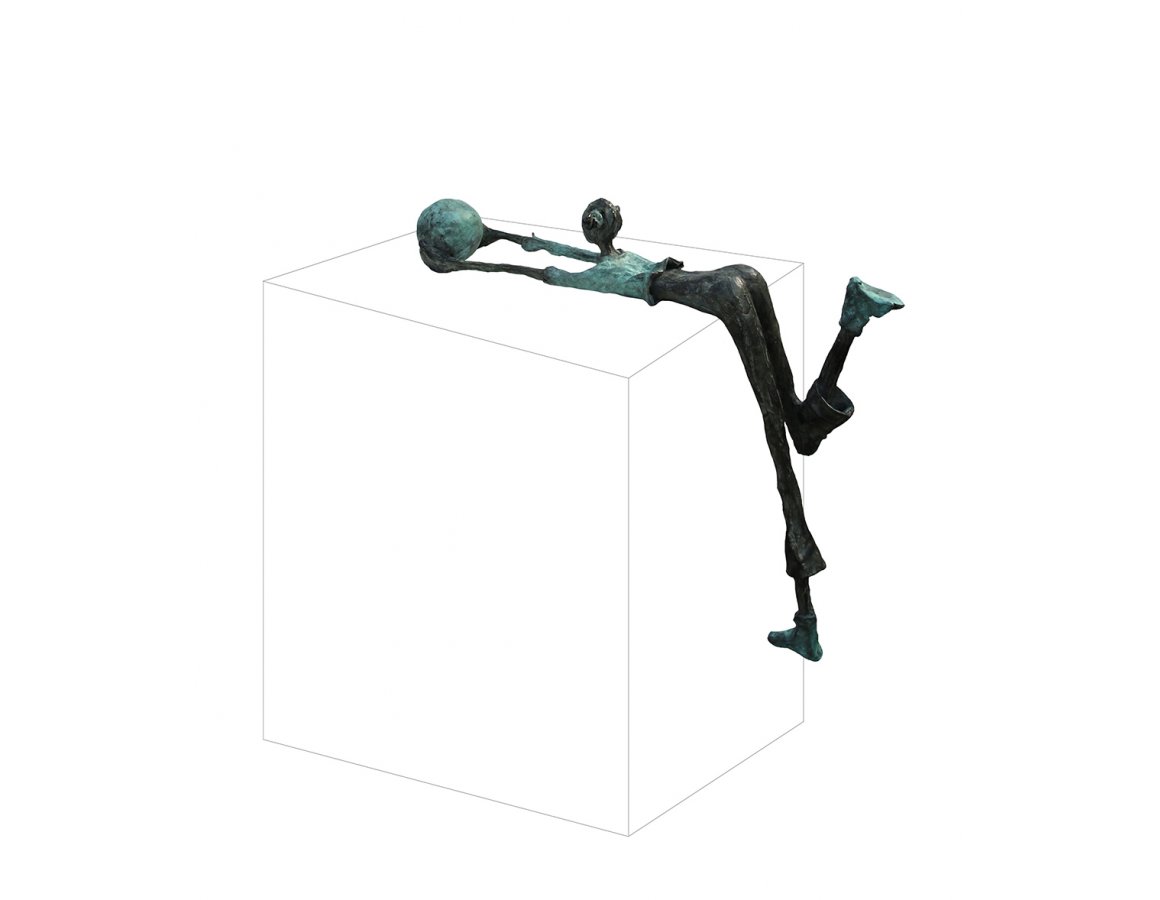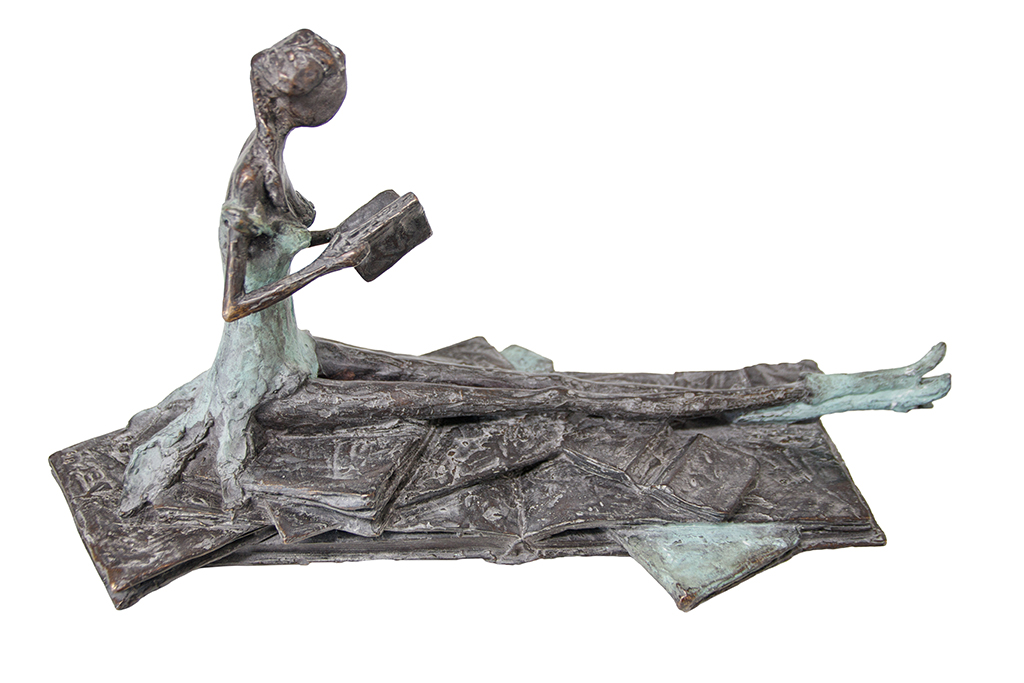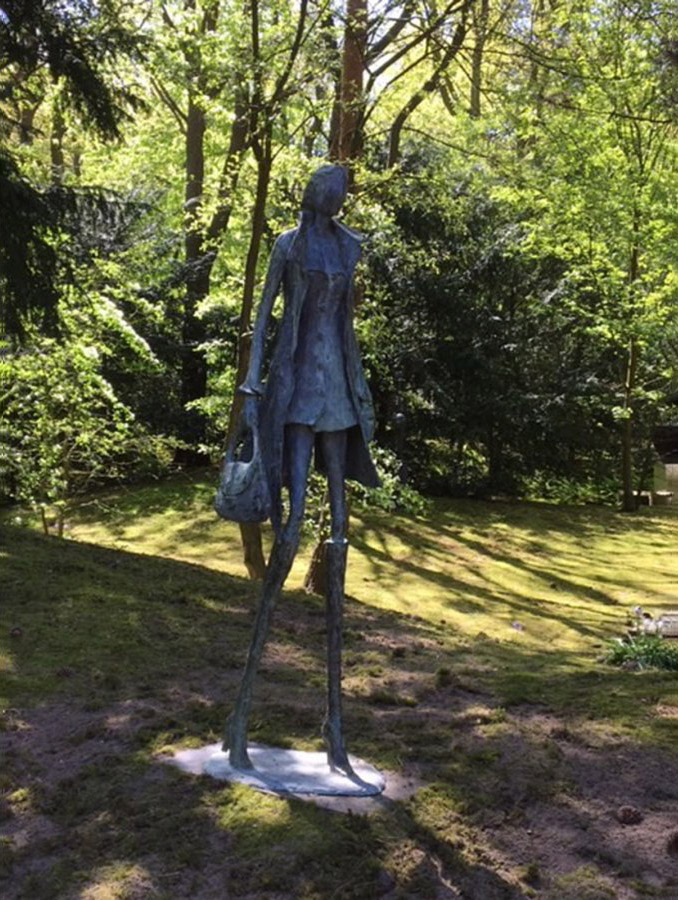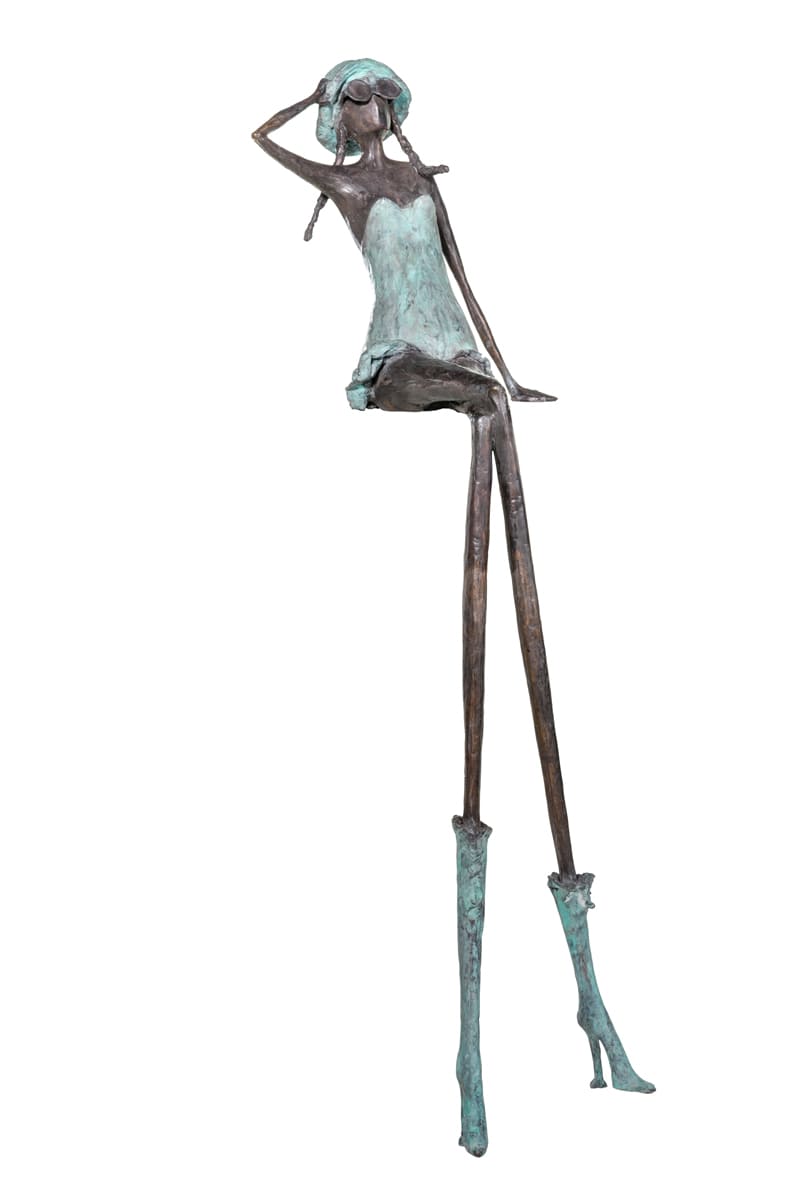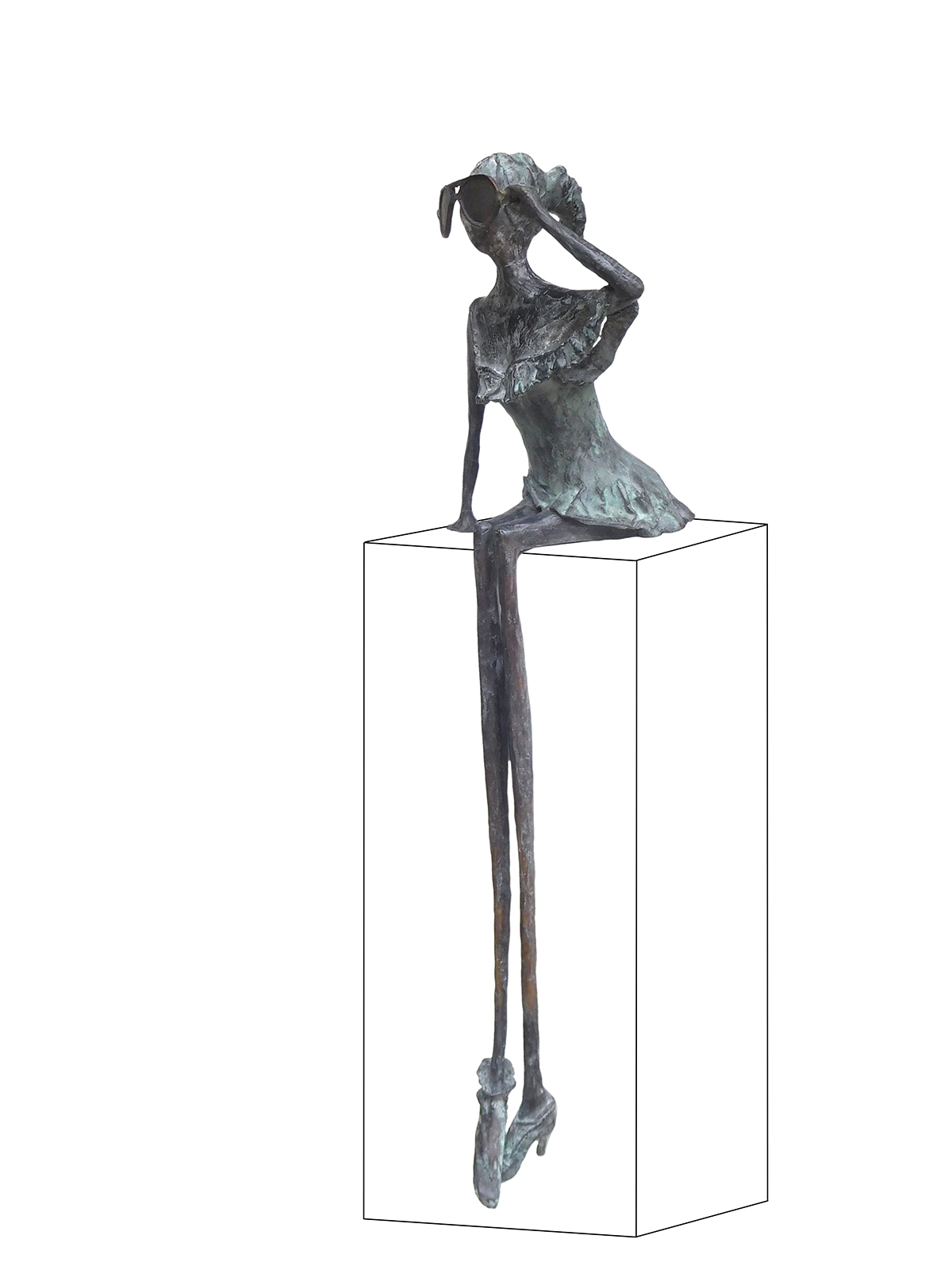Bronze sculptures
Elegance, strength and a zest for life
Over recent years, Astrid Huisman-Biemans has created an impressive series of bronze sculptures. It consists of a succession of female figures, each with a striking appearance. ‘Go with the flow’ is the title of one of these sculptures, and ‘Sunny girl’ and ‘My favourite shoes’ are two others. The latter depicts a woman with distinctively long legs, wearing beautiful shoes. Proudly she looks down at her feet, happy and content.
Fashion as an expression of enjoyment is one of the motifs appearing with some regularity in Huisman-Biemans’ work. The character depicted is enjoying the moment and is happy in life. Other motifs often appearing in her oeuvre are books (reading is then depicted as a moment of introspection, a moment at which the character is alone and happily lost in the story being told) and motion. The focus on movement seems to contrast starkly with the moments of quiet when the character is enjoying herself. And yet there are similarities. Each time, Huisman-Biemans emphasises a point in time just before the character makes a decision and starts moving, such as in ‘Catwalk’, a bronze sculpture of a woman with her head held high. Her coat is billowing out in the wind, which makes it clear that the woman is outdoors. ‘Elle est très belle!’ is a sculpture of a woman who seems to be running away, a large bag in her hand.
Searching for words to describe Huisman-Biemans’ sculptures, you will inevitably arrive at ‘elegance’, ‘strength’ and ‘a zest for life’. Elegance springs to mind because of the long, beautiful legs that form lines as if drawn. The legs carry the body, represent strength and moving forward, continuing to live. A zest for life goes hand in hand with self-esteem. It’s about pride, but also enjoyment. The story behind the characters is represented by the attributes they wear or carry – nice shoes, a bag, an umbrella, a balloon. The gestures depicted reinforce the feeling evoked by each bronze sculpture. The characters’ hairstyles are also carefully considered and crafted. What is on the mind of that girl stretching out her legs in such a frivolous way? What is that regal woman wearing all those summer hats dreaming of? Huisman-Biemans’ bronze sculptures exude power and joy. They are redolent of casual introspection, something that is wonderfully appropriate in that sunny or shady spot in the garden, or in a stylish interior.
A strong combination of form and story
It is worth examining which components make up Huisman-Biemans’ style and why her bronze sculptures are so contemporary. This is not only due to the optimistic character of the figures but also derives from the spatial effect created by legs and arms, which form long lines. These are strong elements in the composition that enhance the three-dimensional effect and bring Huisman-Biemans’ signature style to the fore. This reveals the fact that she received a classical art education. The clear way in which the long lines are drawn tends towards abstraction, one of the characteristics of modern art. Consider a sculpture such as ‘Ambition’, which consists of three acrobats climbing a ladder. The ladder is a strong shape providing the climbers with a clear framework. Something similar can be seen in ‘Dearness’, a sculpture in which six people are depicted side by side. You see them as individuals, but together they form one silhouette. The artist’s fascination with motion is evident in the couple on a bicycle, captured in bronze. There is a momentum to everything – not just the bike, but also the skirt and other clothing, and the pair’s limbs.
In addition to fashion and fine art, there is a third element that influences the design of and meaning behind Huisman-Biemans’ bronze sculptures: Japan.
If you look closely, you can discern the Japanese philosophy of life in some of the works. This is often a combination of Buddhism and Shintoism, the traditional Japanese religion in which natural forces are revered. Bronze sculptures in a garden setting seem to benefit from this influence in particular. Just as animal figures (such as emblematic cranes) are found alongside water in Japan, so the women depicted by Huisman-Biemans fit into their environment too. Like cranes, they are symbolic of long life and happiness. Being introspective, taking a little me time and indulging in self-care make dealing with what’s going on around you much easier.
Bronze
Huisman-Biemans chooses to cast her garden statues in classic bronze. This is a strong, durable material and so ideal for artworks that will be outside in all weather. In indoor settings, bronze contrasts nicely with furniture and decorated walls. But what is more important to an artist is the way in which the medium – the bronze itself – can be fashioned. Huisman-Biemans plays with the different options for patination. Generally, her bronze sculptures have a dark, matt patina. In contrast, the details of garments and attributes, such as high-heeled shoes or gloves, are given a lighter patina in light green with traces of white. As a result, the details of the carefully considered and sensitively designed figures become tangible and visible. The plait in ‘Elle est très belle!’, the pleats in a skirt, or the thumbprint on the bare back of ‘Sunny Girl’ as she allows the shoulder straps of her dress to hang down – they all seem so lifelike. You just want to reach out and touch them.
Other types of work and other materials
Alongside bronze sculptures and garden statues, Huisman-Biemans produces other artworks, including drawings, also using the sumi-e technique. This is a technique developed in Japan. Sumi-e captures the wonder of the nuances contained in a brushstroke and celebrates the richness found in a single mark. Huisman-Biemans’ ink drawings are generally produced as stand-alone works of art, though her sculptural work is reflected in them.
While black lines predominate in most of Huisman-Biemans’ drawings, she does employ colour too. This is especially evident in her mixed media work (mixed media on Dibond with Plexiglas). These works are a combination of collage techniques and calligraphy. In her inimitable style, Huisman-Biemans depicts situations full of cheerful, agile characters. The works exude energy and a zest for life.
Finally, her sculptures in colour are three-dimensional versions of these drawings. You could also describe them as colourful companion pieces to her bronze sculptures. Using resin as a base, Huisman-Biemans fashions these collages from paint and paper. In her bronze sculptures, the artist treats the skin and uses patination to give greater expression to details. In these mixed technique works, details are made to stand out through the use of colour.
Commissioned work
Astrid Huisman-Biemans also makes bespoke sculptures, incorporating the client’s own personal stories into them. Commissioned works are also carefully designed to fit well into the environment in which they will stand. All in all, this is a very special process that can result in an unforgettable work of art for your home or office.
